Poland Plastic Bottles Market Size
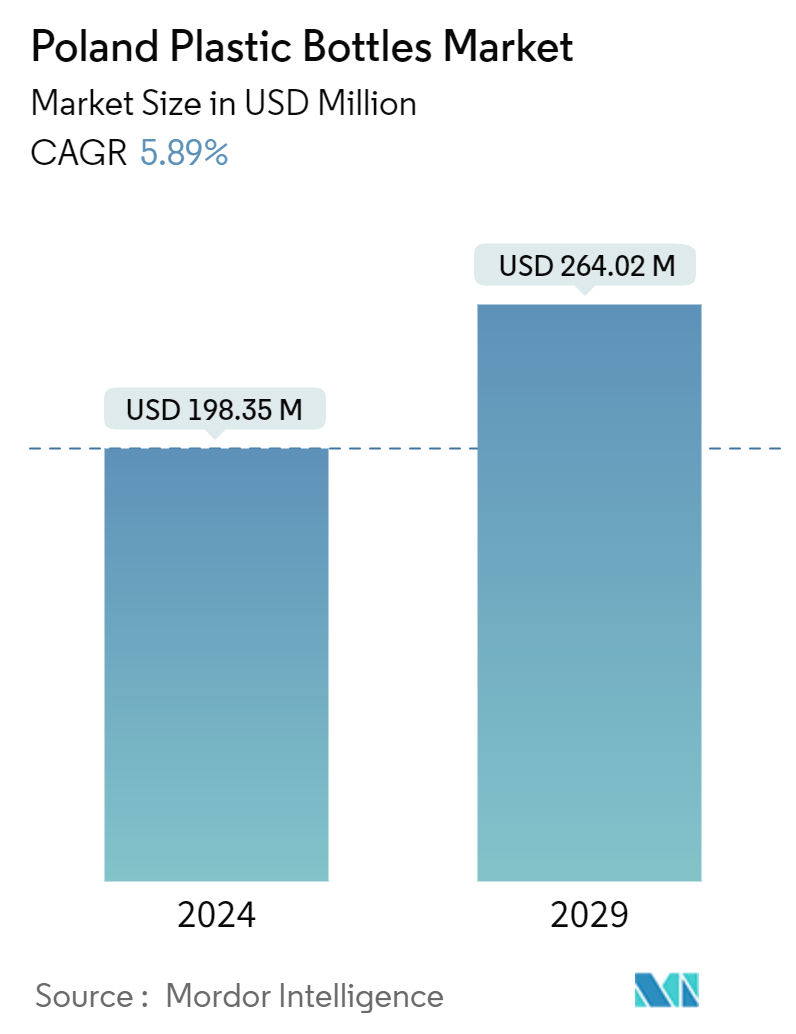
| Study Period | 2019 - 2029 |
| Base Year For Estimation | 2023 |
| Market Size (2024) | USD 198.35 Million |
| Market Size (2029) | USD 264.02 Million |
| CAGR (2024 - 2029) | 5.89 % |
| Market Concentration | Medium |
Major Players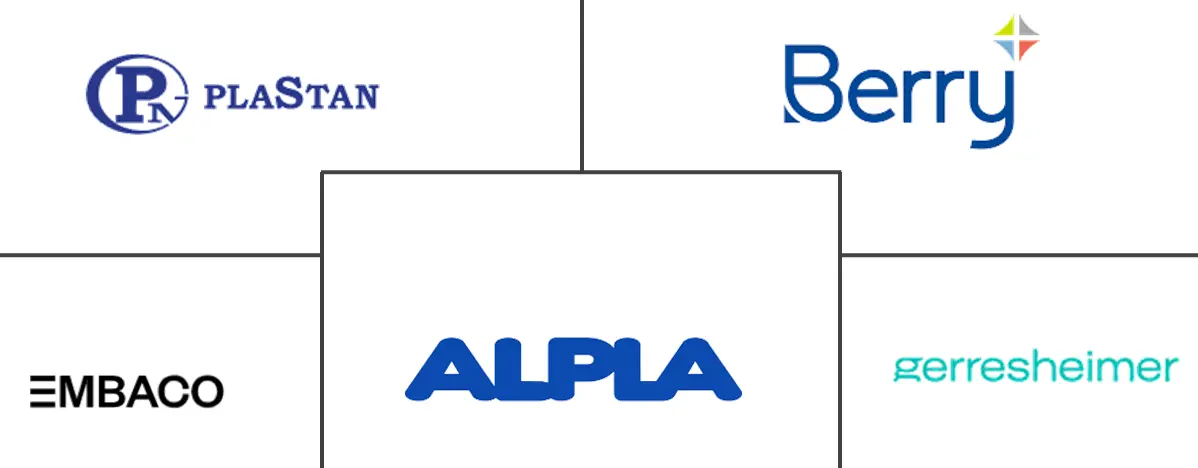
*Disclaimer: Major Players sorted in no particular order |
Poland Plastic Bottles Market Analysis
The Poland Plastic Bottles Market size is estimated at USD 198.35 million in 2024, and is expected to reach USD 264.02 million by 2029, growing at a CAGR of 5.89% during the forecast period (2024-2029). In terms of production volume, the market is expected to grow from 207.52 thousand tonnes in 2024 to 271.27 thousand tonnes by 2029, at a CAGR of 5.5% during the forecast period (2024-2029).
- Plastic bottles in Poland have extensive applications across various industries, with beverages leading the way. This industry encompasses bottled water, soft drinks, juices, and alcoholic beverages, including beer and spirits. The food industry also significantly depends on plastic bottles for items like sauces, dressings, and cooking oils. Beyond food and beverages, the personal care industry utilizes plastic bottles for products such as shampoos and body lotions. Meanwhile, the household cleaning sector relies on plastic bottles to package detergents, cleaners, and other liquid products. The extensive adoption of plastic bottles across these sectors highlights the convenience, affordability, and versatility of plastic as a packaging material, even with its environmental concerns.
- Currently, polyethylene terephthalate (PET) is the predominant material used for plastic bottles. Valued for its lightweight nature, durability, and recyclability, PET is especially favored in the beverage industry for its product-preserving qualities. Other plastics, like high-density polyethylene (HDPE) and polypropylene (PP), are preferred for packaging household and personal care items due to their chemical resistance and toughness. Material technology innovations are emphasizing sustainability in plastic bottles. This includes a heightened focus on recycled PET (rPET) and the development of bio-based plastics sourced from renewable resources. Such advancements aim to mitigate the environmental footprint of plastic bottles by boosting recyclability and curtailing reliance on fossil fuels.
- The Polish government is actively working to enhance recycling rates and curb plastic waste. A significant initiative is the adoption of the EU's Single-Use Plastics Directive, targeting a reduction in the environmental impact of specific plastic products. Furthermore, Poland is considering a deposit return scheme (DRS) for plastic bottles, a strategy that has proven effective in other European nations for elevating recycling rates.
- In September 2023, the Polish Government introduced a bill for a deposit return system (DRS) on beverage containers. Scheduled to launch in January 2025, the new law mandates deposits on single-use plastic bottles (up to 3 liters), reusable glass bottles (up to 1.5 liters), and metal cans (up to 1 liter). Central to the circular economy, the processes of collecting, sorting, and recycling packaging materials enable the repurposing of raw materials like plastic, metal, and glass across multiple lifecycles.
Poland Plastic Bottles Market Trends
Demand For Bottled Beverage Drives Market Growth
- In Poland, the market for plastic bottles is growing, primarily fueled by the surging demand for bottled beverages. Notably, the bottled water segment has witnessed a pronounced surge in consumption over the last decade. This can be attributed to several factors, including a heightened awareness of health, the trend of consuming products on the go, and rising concerns about water quality. Moreover, as Poland's economy expands and living standards improve, consumers are increasingly willing to spend on convenience items like bottled beverages, further propelling the market’s growth.
- There have been substantial investments in new production facilities, alongside a push toward more sustainable packaging solutions. Companies are not only adopting lightweight bottles to minimize plastic use but also delving into incorporating recycled PET (rPET) in their production processes. The move toward rPET is especially significant, aligning seamlessly with EU Directives that advocate for reduced plastic waste and higher recycling rates. Such initiatives not only ensure regulatory compliance for companies but also resonate with environmentally conscious consumers.
- Poland's beverage industry is diversifying its product lineup, introducing an increasing array of flavored waters, functional beverages, and ready-to-drink teas. These offerings, often promoted as healthier substitutes for sugary soft drinks, have garnered a robust market response, amplifying the demand for plastic bottles.
- To cater to the burgeoning demand, beverage companies in Poland are ramping up both their production capacities and distribution networks. In June 2024, BlueTriton, a former Nestlé unit, entered into a reverse merger with Primo Water, a company boasting brands like Mountain Valley and Crystal Springs. Primo Water's valuation surged to a USD 3.6 billion market cap just before the merger announcement, nearly doubling in value over the preceding year. This trend of market consolidation, driven by mergers and acquisitions, enables companies to fortify their market stance and curtail competition.
- Poland's bottled water exports are poised to play a pivotal role in shaping the domestic plastic bottle market. According to the UN Comtrade, Poland exported 52.76 thousand metric tons of bottled water in 2023. As the volume of bottled water destined for international shores increases, the domestic appetite for plastic bottles in Poland is likely to rise, potentially leading to heightened production levels. Such dynamics could exert upward pressure on raw material prices and sway environmental policies concerning plastic waste.
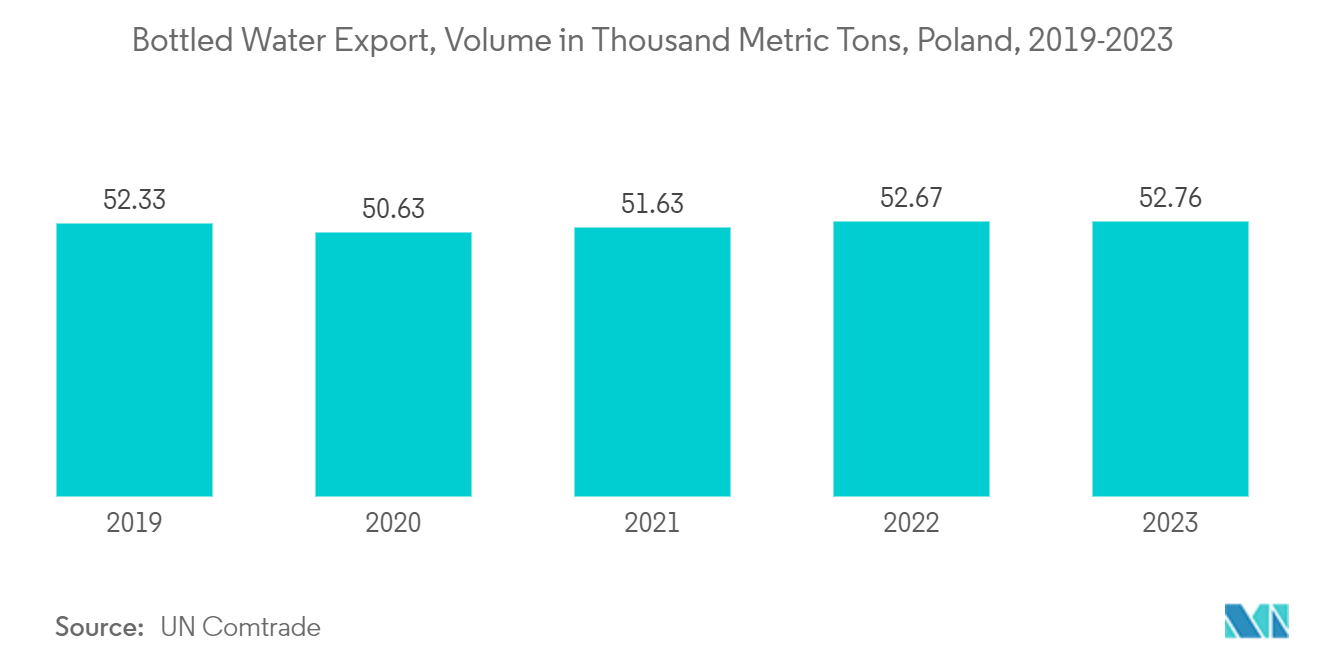
The Established Cosmetics Sector Drives Demand
- Poland's cosmetics market is vibrant and innovative, allowing Polish companies to stand toe-to-toe with global giants. The allure of Polish cosmetics stems from their high quality and unique promotional strategies, a fact recognized by consumers worldwide. Ranking sixth in Europe and fifth in the European Union, Poland boasts a significant cosmetics market.
- Central Statistical Office of Poland stated that, in 2023, Poland's cosmetics industry saw sales surpassing PLN 21.1 billion (USD 5.44 billion). This robust revenue underscored the industry's vitality, boosting the demand for advanced packaging solutions and spurring innovations in the plastic bottles market.
- As per the Polish Investment and Trade Agency (PAIH), both emerging brands and established names predominantly focus on skincare and personal care products, which dominate over 50% of the Polish cosmetics market. This segment is poised to be one of the fastest-growing areas.
- Poland's cosmetics exports reached around EUR 4 billion (USD 4.4 billion), positioning the nation as a leading EU exporter. Poland stands out as the sole EU country that has avoided significant export declines in recent years. While European nations, led by Germany, dominate the export landscape, Poland has notably expanded its horizons, witnessing the most substantial growth in exports beyond Europe. Polish cosmetics such as skincare products, perfumes, and dental care items reach 170 countries, including Japan, Mexico, Taiwan, and South Korea.
- The growth of the cosmetics market directly impacts the plastic bottles market in Poland. As demand for cosmetics rises, so does the need for efficient and innovative packaging solutions. This has led to significant advancements in the market, with companies investing in sustainable and aesthetically appealing packaging to meet consumer preferences.
- The market benefits from the robust performance of the cosmetics industry, ensuring that Polish products remain competitive on the global stage. As the cosmetics market continues to expand, the plastic bottles market is expected to follow suit, driven by the need for high-quality, sustainable packaging solutions.
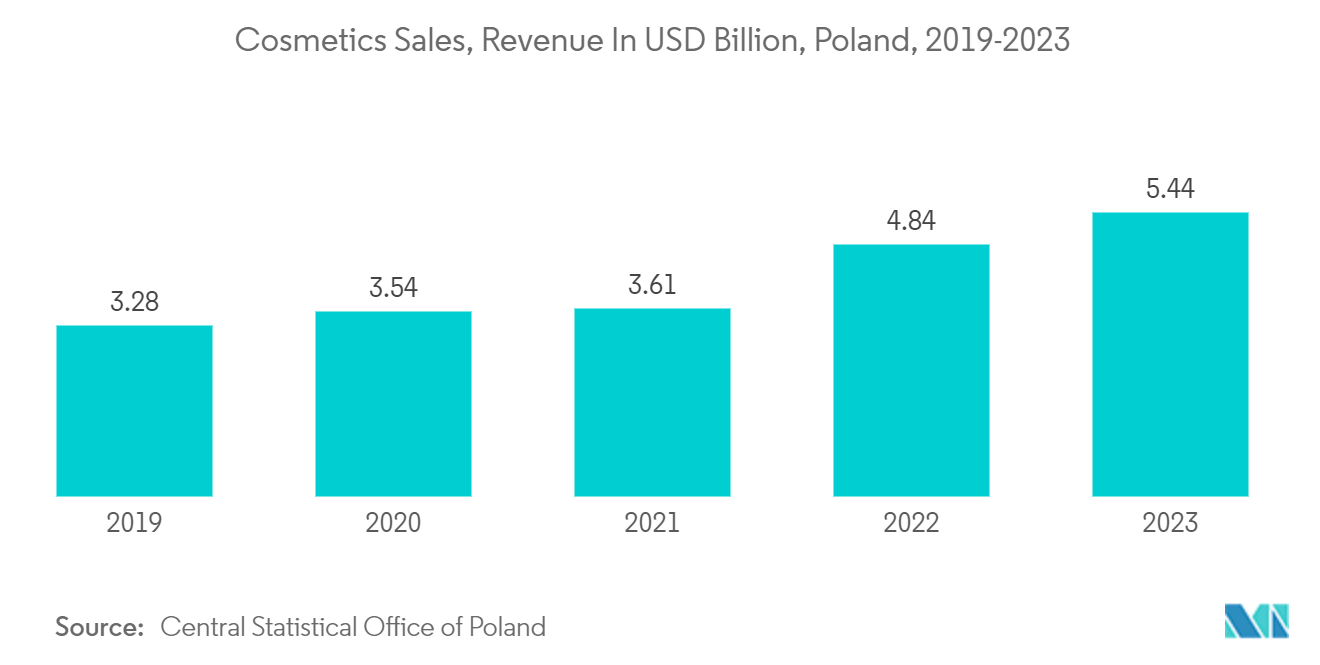
Poland Plastic Bottles Industry Overview
In Poland, the plastic bottles market is fragmented, spearheaded by prominent domestic entities like MPS International and Embaco A/S, alongside global players such as Alpla Group, Berry Global, and Gerresheimer. These frontrunners actively pursue strategies like mergers, acquisitions, and product launches to fortify their foothold in the region.
- August 2023: Berry Global launched 100% recycled PET (rPET) bottles to package a new luxury artesian mineral water. Designed for fast-paced lifestyles, NEUE Water boasts a unique ergonomic flat bottle shape. This design allows it to seamlessly fit into pockets, bags, and even seatback storage on planes and trains. Beyond its recycled content, the bottle's robust construction not only supports multiple refills but also ensures recyclability at the end of its life.
- July 2023: Alpla, an Austrian packaging producer with its own plastic recycling operations, expanded production at its recycling plant in Radomsko, Poland. The company invested approximately USD 8.8 million to install a third extrusion line at the site. With this addition, the annual production capacity at the Radomsko plant converted to 54,000 metric tons of food-grade recycled-content PET (rPET).
Poland Plastic Bottles Market Leaders
-
Gerresheimer AG
-
Berry Global Inc.
-
Alpla Group
-
Embaco A/S
-
Plastan Kacprzyk SP. Z O.O
*Disclaimer: Major Players sorted in no particular order
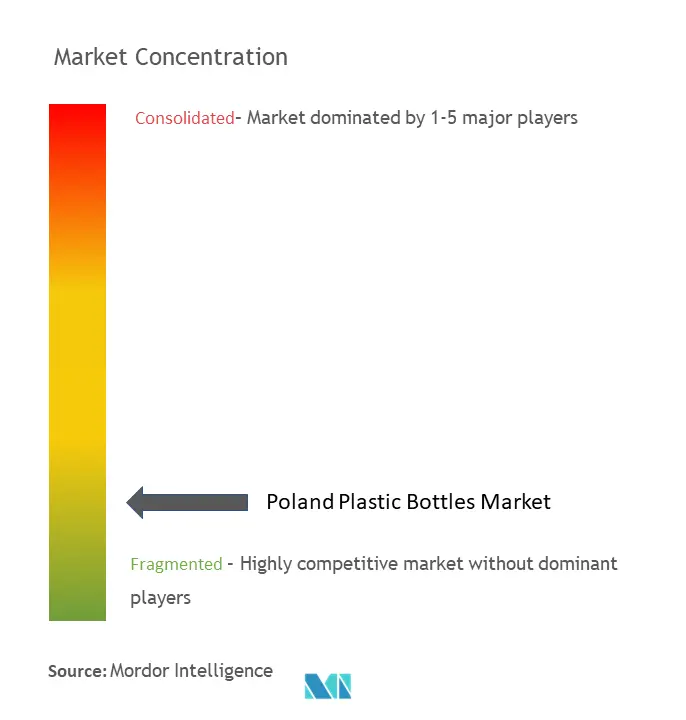
Poland Plastic Bottles Market News
- August 2024: ALPLA unveiled a new PET bottle tailored for Polish mineral water brands Staropolanka and Krystynka. This innovative packaging solution is safe and affordable and mirrors its glass predecessor's premium aesthetic. The new PET bottle retains its original shape and familiar feel, is lighter, and offers more capacity. Weighing in at a mere 32 grams, which is only one-sixth the weight of the glass version, the bottle can hold 380 millilitres of water. This is an increase of 50 millilitres compared to the glass bottle, all while keeping the same external dimensions. The new bottle is fully recyclable in line with ALPLA's sustainability commitment.
- May 2023: Poland adopted a law to progressively implement the EU directive's obligations between 2023 and 2025. In Poland, the packaging industry consumes nearly 35% of the plastics processed by Polish manufacturers. However, the recycling rate for plastics lagged behind that of other materials. Following the enforcement of the EU SUP Directive on July 3, 2021, which aims to mitigate the environmental impact of specific plastic products, the Polish government was mandated to enact corresponding national legislation.
Poland Plastic Bottles Market Report - Table of Contents
1. INTRODUCTION
- 1.1 Study Assumptions and Market Definition
- 1.2 Scope of the Study
2. RESEARCH METHODOLOGY
3. EXECUTIVE SUMMARY
4. MARKET INSIGHTS
- 4.1 Market Overview
-
4.2 Industry Attractiveness - Porter's Five Forces Analysis
- 4.2.1 Bargaining Power of Suppliers
- 4.2.2 Bargaining Power of Consumers
- 4.2.3 Threat of New Entrants
- 4.2.4 Threat of Substitute Products
- 4.2.5 Intensity of Competitive Rivalry
- 4.3 Industry Value Chain Analysis
5. MARKET DYNAMICS
-
5.1 Market Drivers
- 5.1.1 Increasing Adoption of Lightweight Packaging Methods
- 5.1.2 Changing Demographic and Lifestyle Factors
-
5.2 Market Restraints
- 5.2.1 Growing Environmental Concerns Over the Use of Plastics
-
5.3 Trade Scenario
- 5.3.1 EXIM Data
- 5.3.2 Trade Analysis (Top 5 Import-Export Countries, Price Analysis, and Key Ports, Among others)
- 5.4 Trade Analysis (Top 5 Import-Export Countries, Price Analysis, and Key Ports, Among others)
- 5.5 Industry Regulation, Policy and Standards
- 5.6 Technology Landscape
-
5.7 Pricing Trend Analysis
- 5.7.1 Plastic Resins (Current Pricing and Historic Trends)
6. MARKET SEGMENTATION
-
6.1 By Resin
- 6.1.1 Polyethylene (PE)
- 6.1.2 Polyethylene Terephthalate (PET)
- 6.1.3 Polypropylene (PP)
- 6.1.4 Other Resin type (Polystyrene, PVC, Polycarbonate, etc.)
-
6.2 By End-use Industries
- 6.2.1 Food
- 6.2.2 Beverage
- 6.2.2.1 Bottled Water
- 6.2.2.2 Carbonated Soft Drinks
- 6.2.2.3 Alcoholic Beverages
- 6.2.2.4 Juices & Energy Drinks
- 6.2.2.5 Other Beverage
- 6.2.3 Pharmaceuticals
- 6.2.4 Personal Care & Toiletries
- 6.2.5 Industrial
- 6.2.6 Household Chemicals
- 6.2.7 Paints & Coatings
- 6.2.8 Other End-use Industries
7. COMPETITIVE LANDSCAPE
-
7.1 Company Profiles*
- 7.1.1 Gerresheimer AG
- 7.1.2 Berry Global Inc.
- 7.1.3 Alpla Group
- 7.1.4 Polimer sp. z o.o.
- 7.1.5 Plastan Kacprzyk SP. Z O.O. SP. K.
- 7.1.6 Bech Packaging sp. z o.o.
- 7.1.7 PetRing Sp. z. o. o.
- 7.1.8 Rosinski Packaging Sp. z o.o.
- 7.1.9 Embaco A/S
- 7.1.10 K.G. International Inc.
- 7.2 Heat Map Analysis
- 7.3 Competitor Analysis - Emerging vs. Established Players
8. RECYCLING & SUSTAINABILITY LANDSCAPE
9. FUTURE OF THE MARKET
** Subject To AvailablityPoland Plastic Bottles Industry Segmentation
The scope characterizes the market based on the product's raw materials, including PP, PE, PET, and other raw materials used across various end-user industries, such as food, pharmaceuticals, beverages, cosmetics, and toiletries, across various countries. The report also examines underlying growth influencers and significant vendors, all of which help to support market estimates and growth rates for the forecast period. The market estimates and projections are based on the base year, using both top-down and bottom-up approaches.
The Polish plastic bottles market is segmented by resin (polyethylene (PE), polyethylene terephthalate (PET), polypropylene (PP), and other resin types) and end-use industries (food, beverages (bottled water, carbonated soft drinks, alcoholic beverages, juices and energy drinks, and other beverages), pharmaceuticals, personal care and toiletries, household chemicals, paints and coatings, and other end-use industries). The market sizing and forecasts are provided in terms of value (USD) and volume (tonnes) for all the above segments.
| By Resin | Polyethylene (PE) | |
| Polyethylene Terephthalate (PET) | ||
| Polypropylene (PP) | ||
| Other Resin type (Polystyrene, PVC, Polycarbonate, etc.) | ||
| By End-use Industries | Food | |
| Beverage | Bottled Water | |
| Carbonated Soft Drinks | ||
| Alcoholic Beverages | ||
| Juices & Energy Drinks | ||
| Other Beverage | ||
| Pharmaceuticals | ||
| Personal Care & Toiletries | ||
| Industrial | ||
| Household Chemicals | ||
| Paints & Coatings | ||
| Other End-use Industries |
Poland Plastic Bottles Market Research FAQs
How big is the Poland Plastic Bottles Market?
The Poland Plastic Bottles Market size is expected to reach USD 198.35 million in 2024 and grow at a CAGR of 5.89% to reach USD 264.02 million by 2029.
What is the current Poland Plastic Bottles Market size?
In 2024, the Poland Plastic Bottles Market size is expected to reach USD 198.35 million.
Who are the key players in Poland Plastic Bottles Market?
Gerresheimer AG, Berry Global Inc., Alpla Group, Embaco A/S and Plastan Kacprzyk SP. Z O.O are the major companies operating in the Poland Plastic Bottles Market.
What years does this Poland Plastic Bottles Market cover, and what was the market size in 2023?
In 2023, the Poland Plastic Bottles Market size was estimated at USD 186.67 million. The report covers the Poland Plastic Bottles Market historical market size for years: 2019, 2020, 2021, 2022 and 2023. The report also forecasts the Poland Plastic Bottles Market size for years: 2024, 2025, 2026, 2027, 2028 and 2029.
Poland Plastic Bottles Industry Report
Statistics for the 2024 Poland Plastic Bottles market share, size and revenue growth rate, created by Mordor Intelligence™ Industry Reports. Poland Plastic Bottles analysis includes a market forecast outlook for 2024 to 2029) and historical overview. Get a sample of this industry analysis as a free report PDF download.



